Category Archives: Uncategorized
Vincent Bugliosi’s Opening Statement
Thursday, January 3rd, 2013
Jan. 3 – The 13-paged opening statement Deputy District Attorney Vincent Bugliosi handed out to members of the press on the morning of Friday, July 24, 1970.
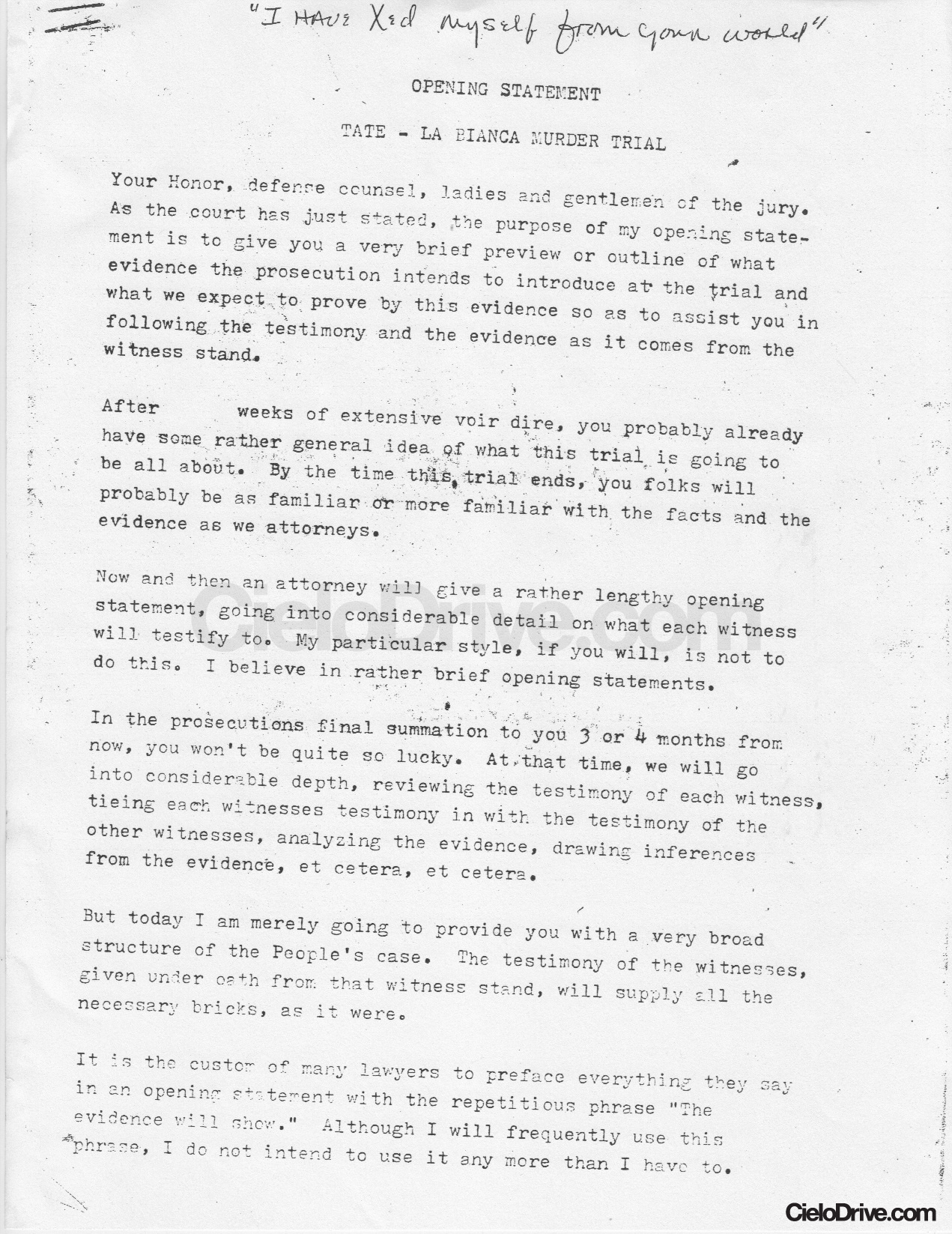
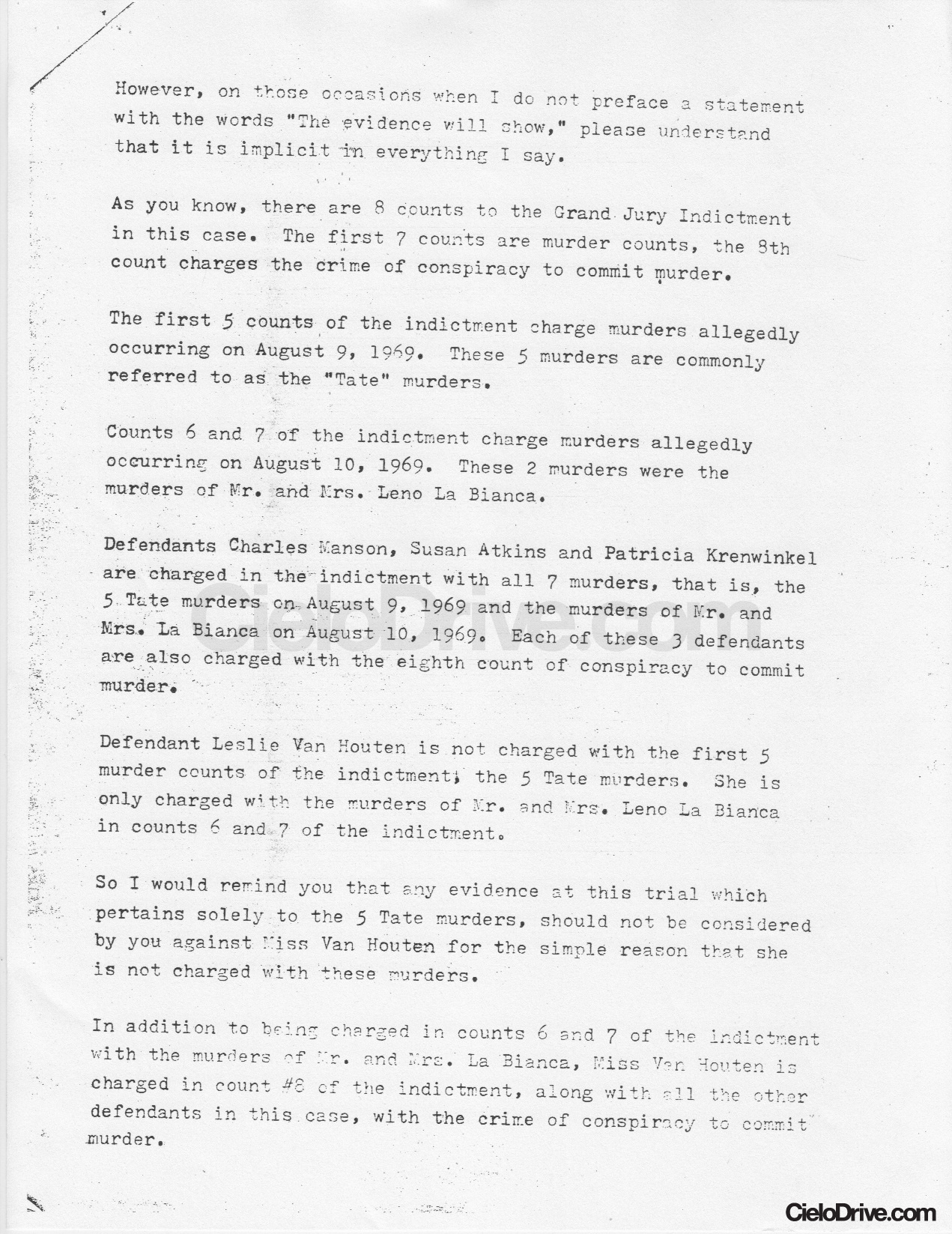
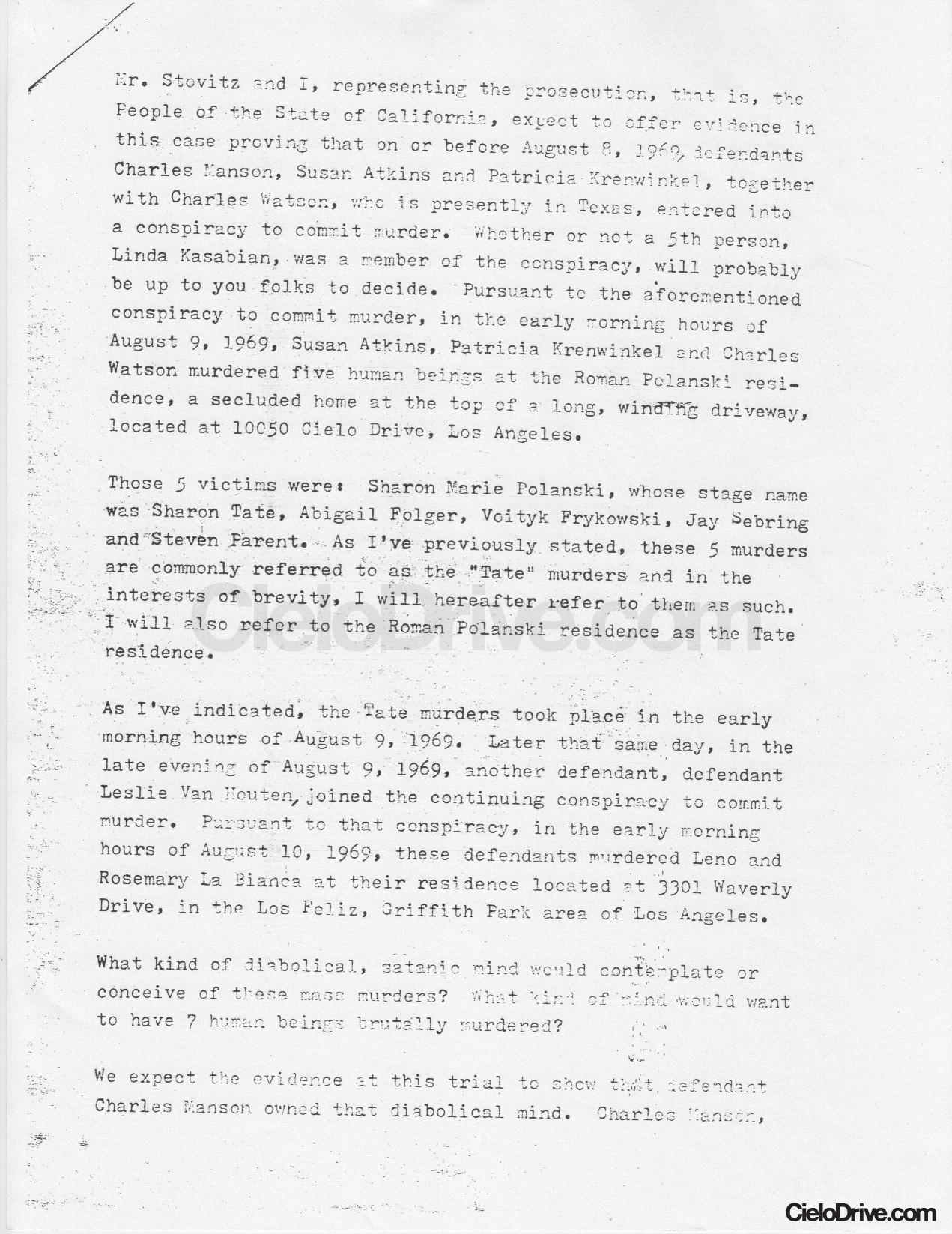
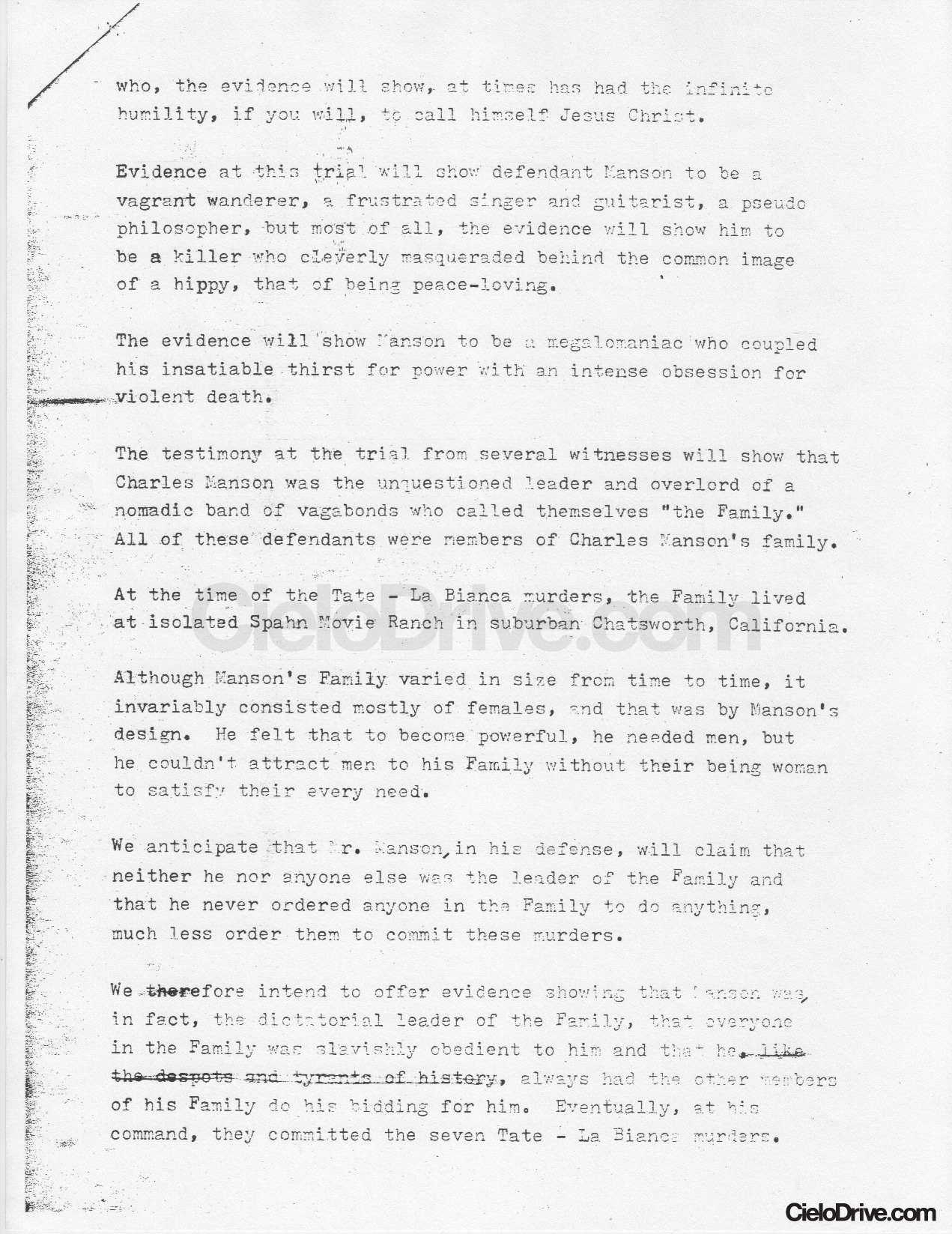
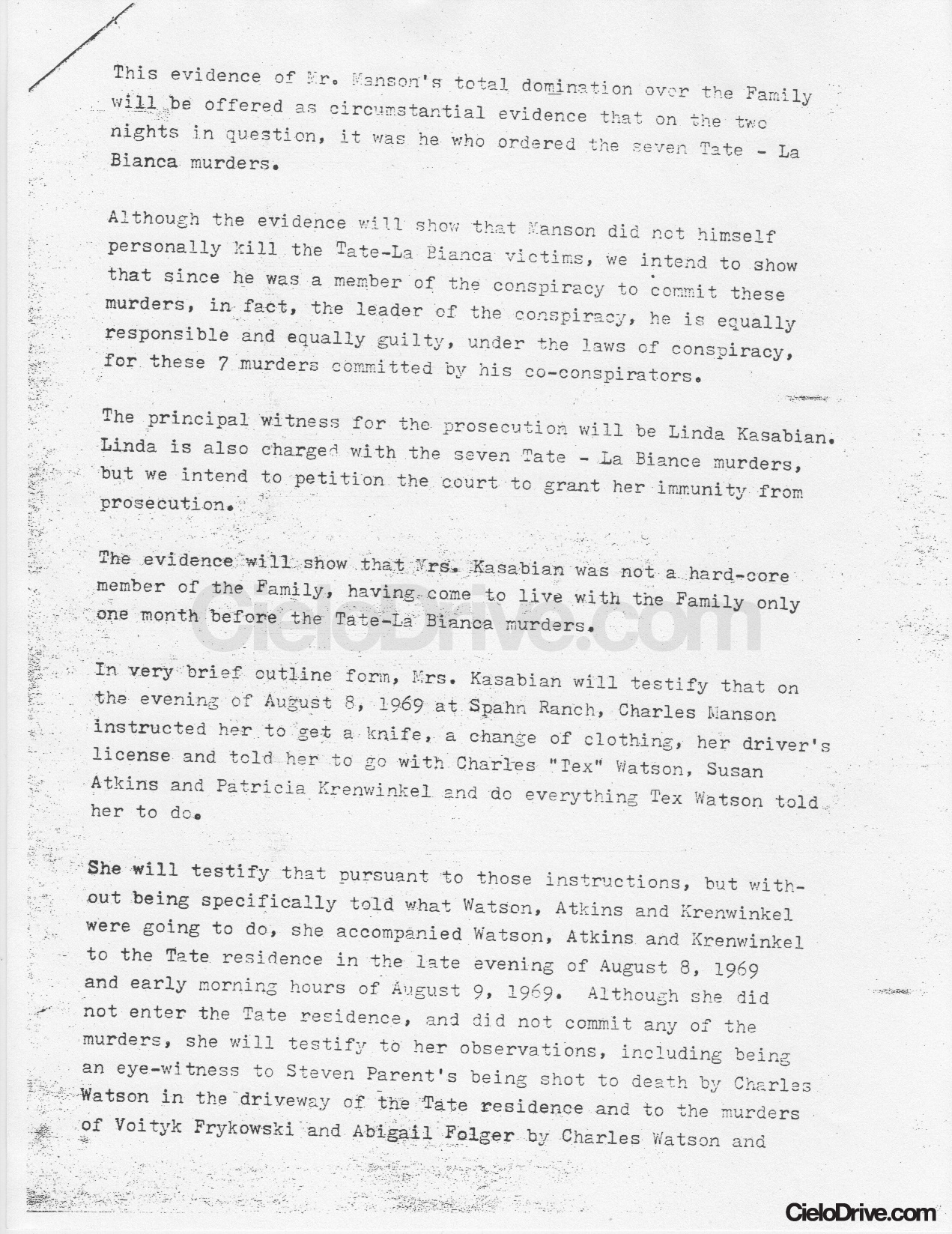
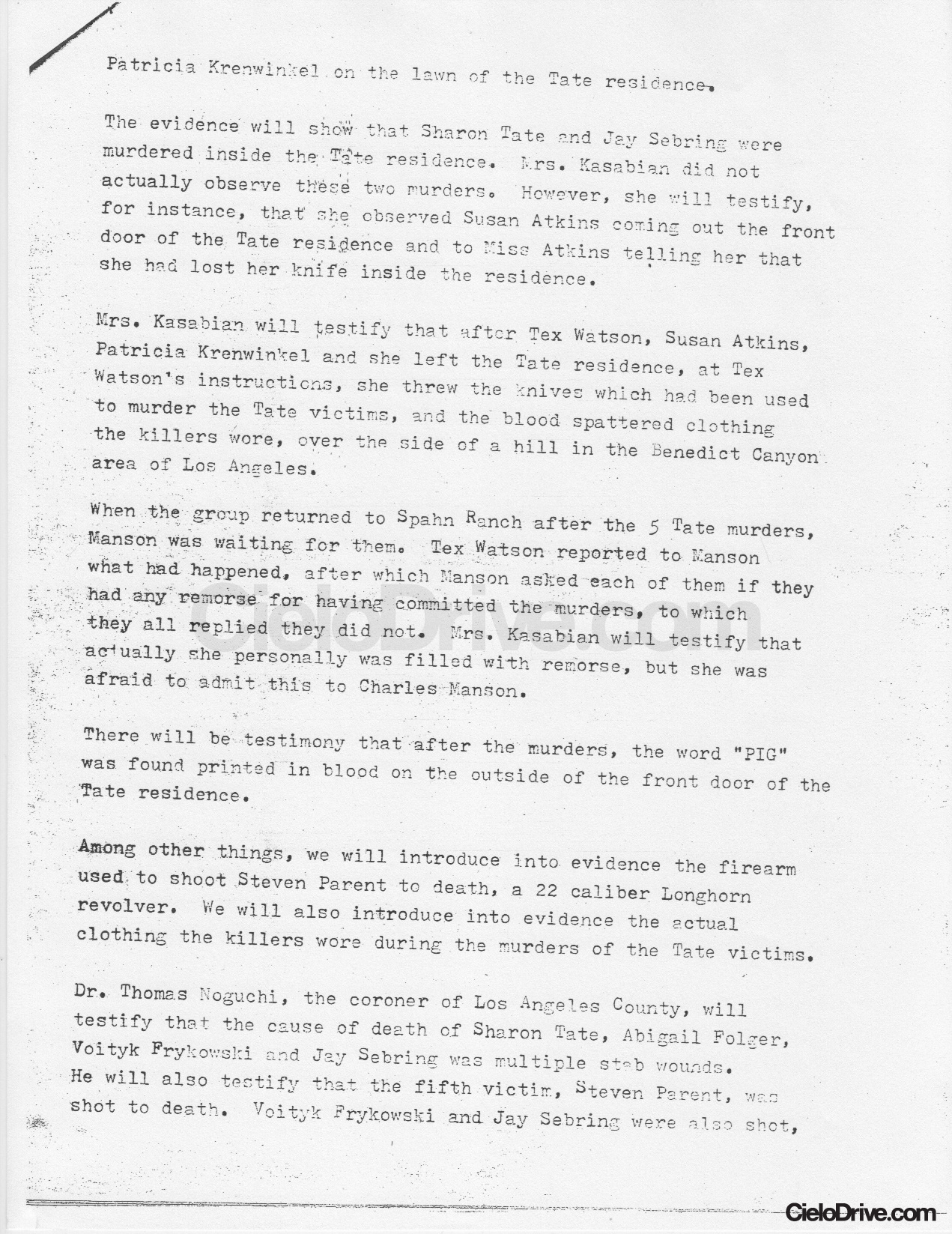
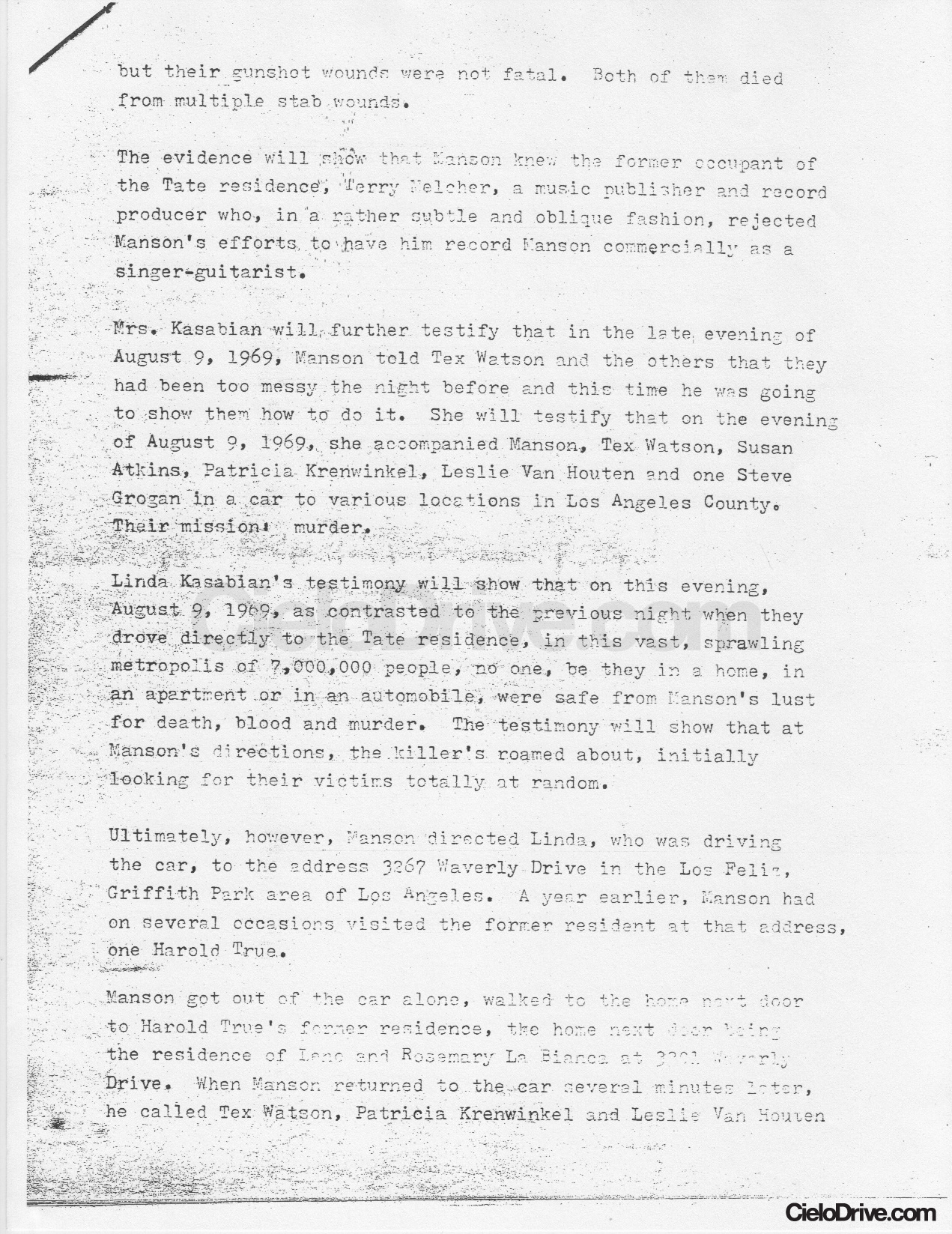
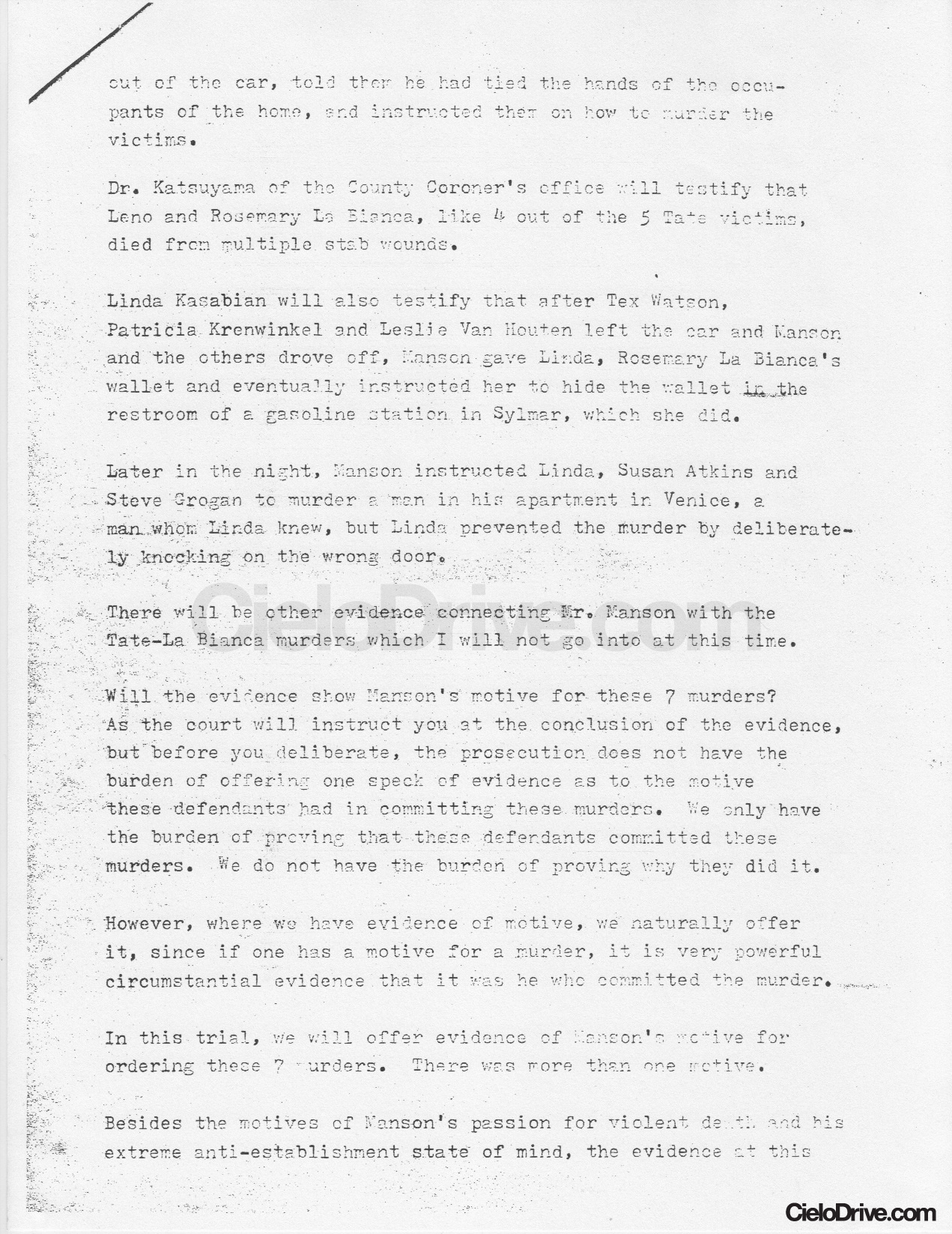
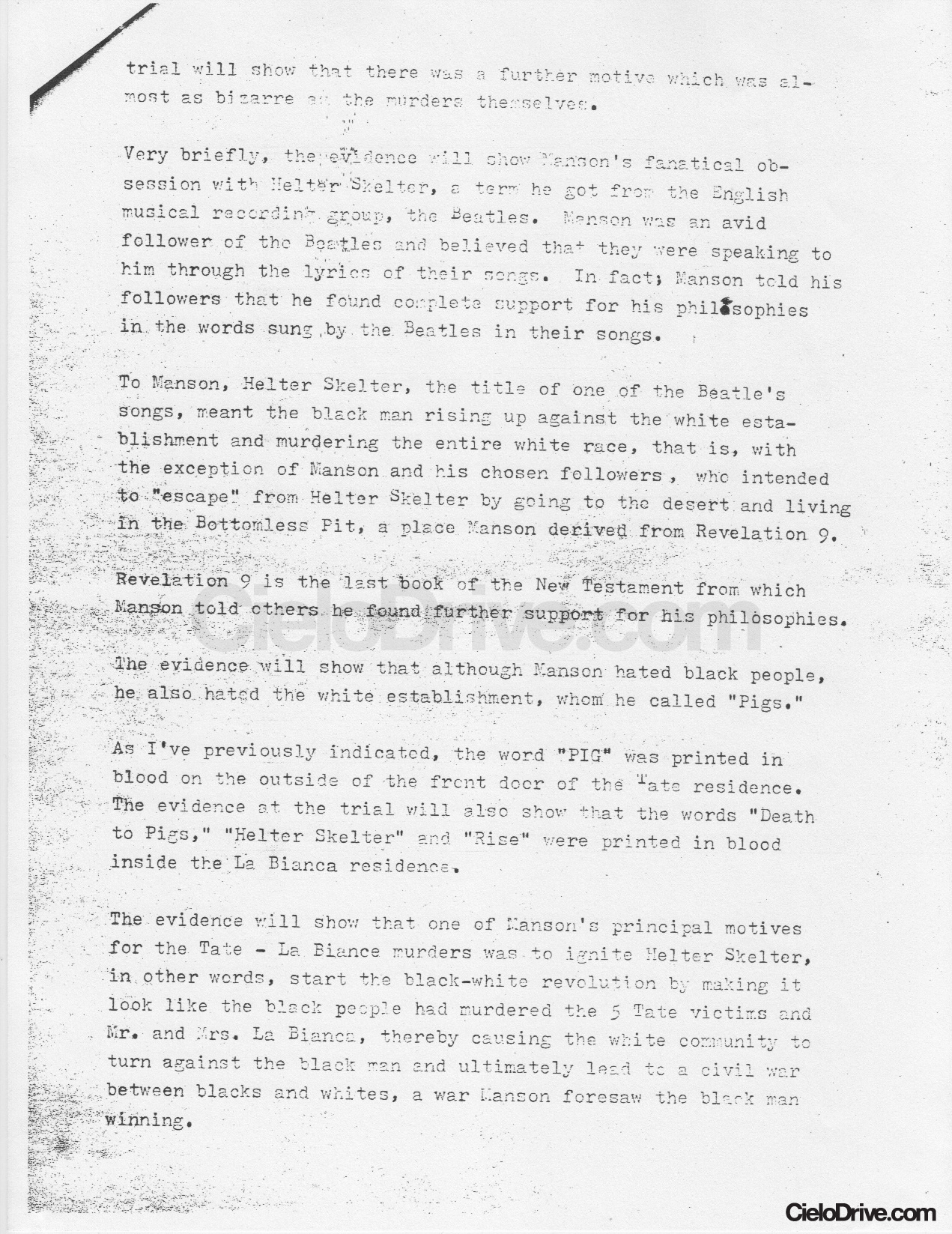
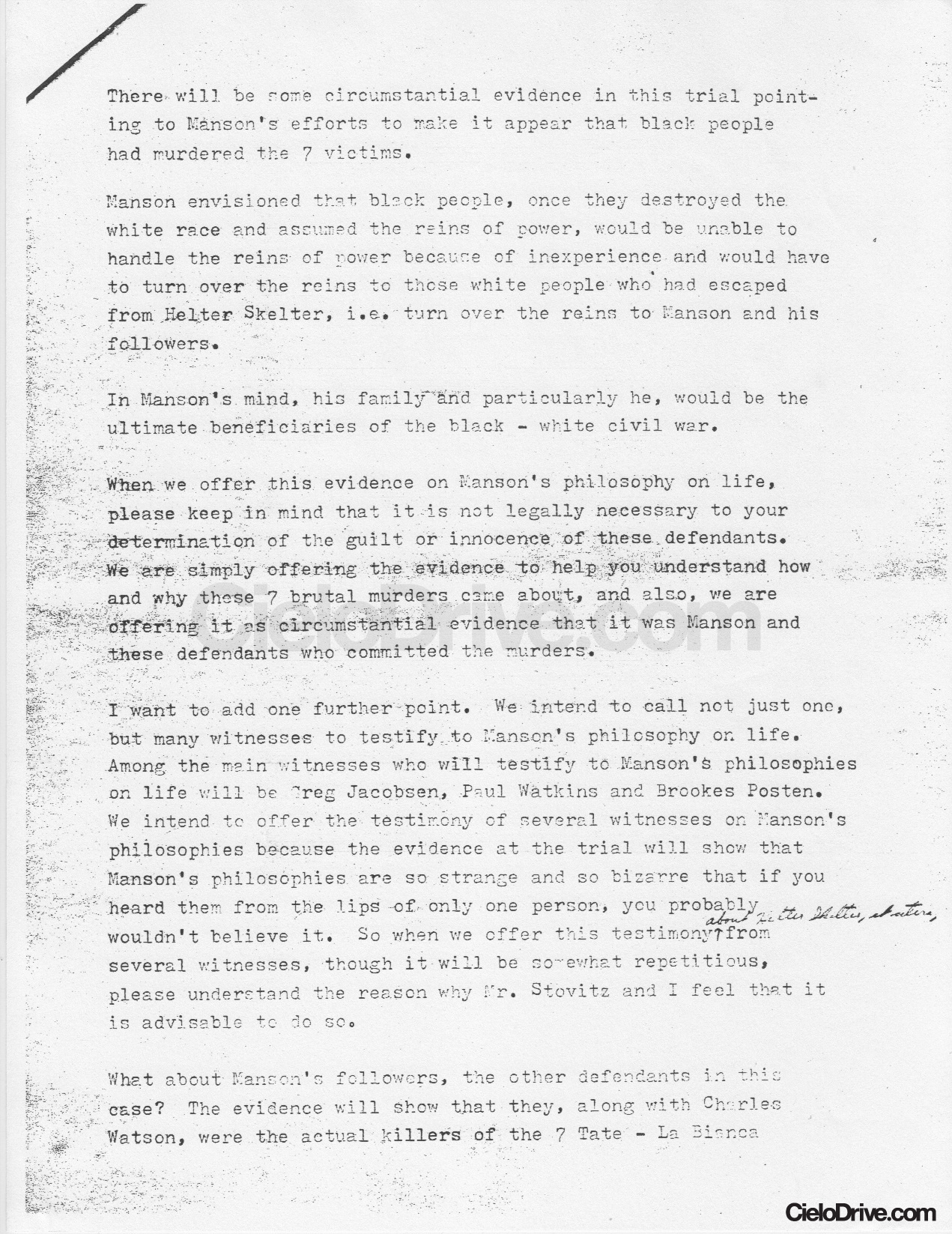


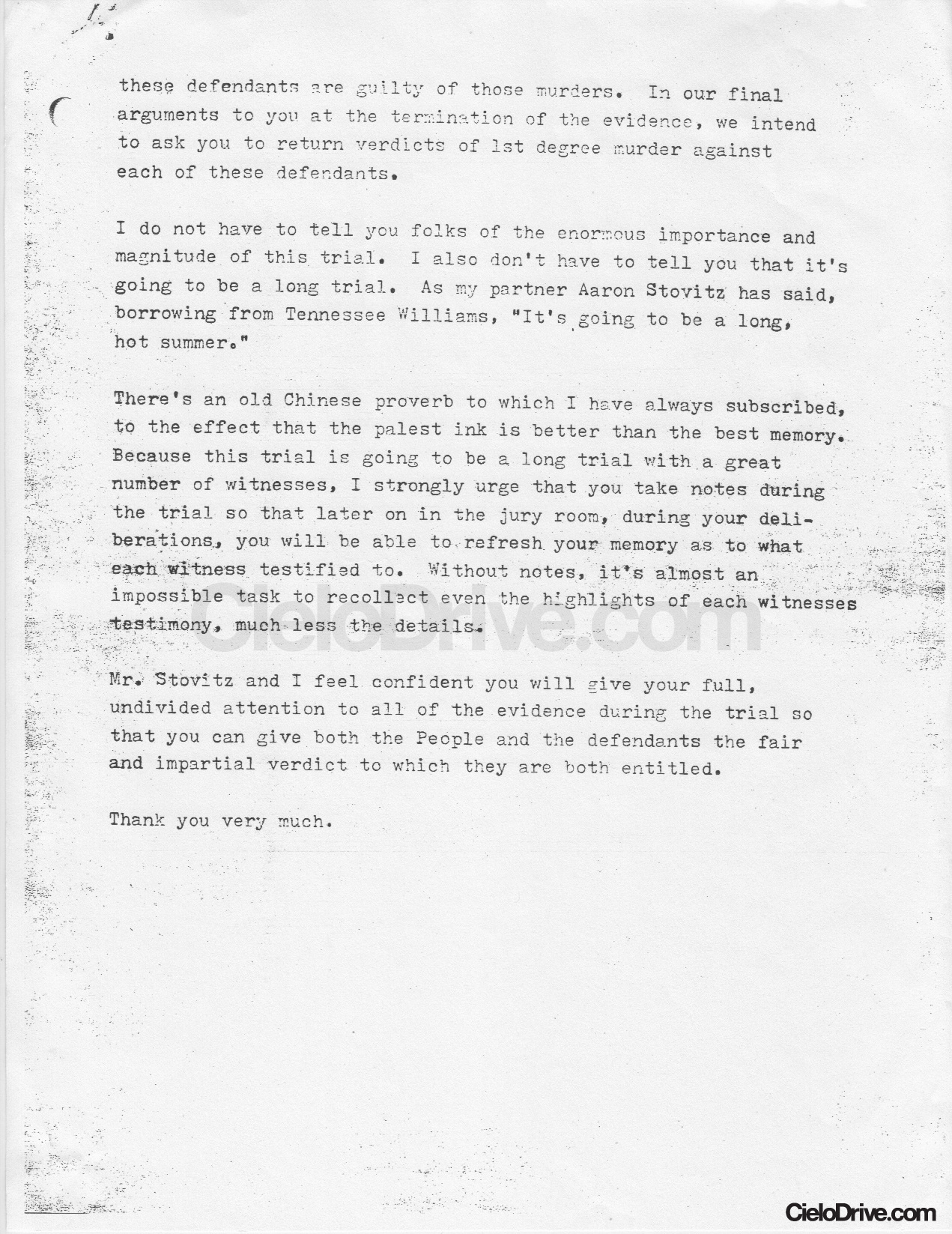
Executive Review: The Next Step
Thursday, December 6th, 2012
Dec. 6 – Next February, Bruce Davis’ case and parole decision will land on the desk of Governor Jerry Brown, where it will undergo it’s final review. Brown will have 30 days to review Davis’ case and prison records, and then affirm, modify or reverse the Board of Parole Hearings’ decision to grant him parole.
This process is nothing knew for Davis. In June of 2010, then governor, Arnold Schwarzenegger reversed a Board of Parole Hearings decision that would’ve granted Davis parole, saying, “I believe his release would pose an unreasonable risk of danger of society at this time.”
Two months ago, Parole Commissioner Jeffrey Ferguson asked Bruce Davis about his reaction to former governor Schwarzenegger’s reversal.
“I’m very sad that the Board’s decision was vetoed,” answered Davis.
When Ferguson inquired if Davis had read Schwarzenegger’s letter, he responded, “I read it more than once and at the end of reading it, I realized that I should have been more explicit in my assumption of responsibility for my crimes.”
“Do you think that the Governor made some valid points?” questioned Ferguson.
“I recognized the Governor’s concerns, his worries, his suspicions, and everything has a degree of validity, I suppose,” said Davis.
Davis, 70, is serving a life sentence for the murders of Gary Hinman and Donald “Shorty” Shea, and has been in prison since April 21, 1972. Since that time, Bruce has been active in many self-help and spiritual groups within the prison. His prison disciplinary record is near spotless, with only 2 rules violations in over 40 years, last one occurring over three decades ago.
Davis has continued his education, receiving a Master’s degree from Borean School of the Bible. In 1998, he received a Doctorate degree in philosophy and religion from Bethany Seminary, graduating summa cum laude.
“By no conceivable stretch of anyone’s imagination has Bruce Davis not rehabilitated himself,” said Davis’ attorney Michael Beckman. “No one, not even the District Attorney from Los Angeles County said anything negative about his prison program.”
In October, a California Parole Board granted him parole for the second time in as many hearings.
“You’ve lived in a very difficult environment for over 40 years and you’ve managed to completely avoid any violence whatsoever,” Commissioner Ed Alvord told Davis, after announcing the board’s decision to granted him parole. “You’re to be commended for that. That’s not an easy thing to accomplish, especially not for that length of time.”
Whether or not the decision will be upheld after the review process, is still up for debate. In February, the AP reported that Governor Brown has allowed about 80 percent of decisions by the parole board to free convicted killers. While Former Governor Schwarzenegger had allowed only 25 percent and Governor Gray Davis allowed just 2 percent to walk free.
According to the 2011 Executive Report on Parole Review Decisions, Governor Brown reversed or modify the parole decisions for 71 inmates, 28 of which, were first degree murderers. Reasons given for the reversals ranged. According to Brown, some inmates lacked insight, some minimized their culpability, and others posed an unreasonable risk of danger to society.
While none of the 71 inmates whose paroles were reversed by Brown in 2011 had been incarcerated as long as Davis, some of the cases dated back to the 1970’s.
In March of 2011, Governor Brown reversed the parole decision for Calvin Thornton, who in 1972, conspired with Phillip Ross, to rob James Dover, a neighbor they had just purchased drugs from. When Dover refused to give the two men money, Thornton and Ross beat him to death.
According the Thornton’s parole decision, “the Board of Parole Hearings found Mr. Thornton suitable for parole based upon his participation in self-help programs and vocational training, positive institutional work record, realistic parole plans, enhanced ability to function within the law upon release, expressions of remorse, and reduced risk of recidivism due to age.”
Governor Brown commended Thornton’s prison accomplishments, but said they were “outweighed by negative factors that demonstrate he remains unsuitable for parole.”
“[Thornton and Ross] were motivated solely by their desire for money,” continued Brown, “a very trivial motive in relation to the offense. The two men carried out the attack in an unnecessarily gruesome manner demonstrating an extreme callous disregard for the suffering victim.”
In 10 of 71 cases Governor Brown reversed in 2011, Brown noted that opposition from the District Attorney’s office, police agencies, and victim’s next-of-kin, factored into his decision to reverse. In one case, Brown even indicated potential public outrage was a factor in his decision.
This will be a significant hurdle for Davis, since his release is opposed by the Los Angeles County Sheriff’s Office, the District Attorney, members of the Shea and Hinman families, and the public.
Also opposing Davis’ release, are Sharon Tate’s younger sister Debra Tate and former Manson family member Barbara Hoyt. Both attended Davis’ October hearing and read opposition letters from Hinman and Shea families.
Debra Tate spoke first, reading a letter to the board from Gary Hinman’s cousin, Kay Martley.
“Gary was killed under horrific circumstances and Bruce Davis was there and took part in his death,” wrote Martley. “Gary had never done anything that would have given Bruce Davis or Manson the right to take his life. Why should Bruce Davis have freedom?”
Following Tate, Hoyt read letters from Donald Shea’s first wife, Phyllis Arlene Gaston Shea Murphy, and his daughter, Karen Shea.
“I lived my life growing up wondering just what was my father like,” wrote Karen. “I was denied the chance to ever get to know my dad by the selfish, cruel, immoral actions of the people who murdered him when I was merely a child.”
After reading the letters, Hoyt went on and related her own experiences with the Family and Bruce Davis’ role in it. Unlike Tex Watson, who Hoyt referred to as a “very happy-go-lucky goofy guy who was submissive to Charlie in every way,” Davis was feared by the girls, whom he seemed to enjoy bossing around.
“The first killing that he participated in, that of Gary Hinman, didn’t phase him,” said Hoyt. “He still stayed. The deaths of seven more victims didn’t bother him enough to leave. He then helped murder Shorty Shea. Now nine murders have occurred and he still stayed. He was present when Zero was killed.”
Hoyt has opposed Davis’ release for years and testified at an En Banc hearing in November of 2006, after Davis received a split-decision earlier that year.
Hoyt’s testimony is a significant issue for Davis, because her account of Donald Shea’s murder contradicts Davis’ version. Davis claims it occurred in the morning, while Hoyt insists it happened at night. If Governor Brown believes Hoyt, he will have to conclude that Davis is still not being truthful about the crime. That alone would be grounds for Governor Brown to reverse the board’s decision to parole Davis.
It’s anyone’s guess, whether or not Governor Brown will see Davis as a rehabilitated man, or as a dangerous killer still withholding information about his crimes. Until February, like Davis himself, we will wait and wonder.
The Guesthouse House Guests
Tuesday, October 30th, 2012
Oct. 29 – In June of 1968, Dean Moorehouse and Brooks Poston left Ukiah, California, driving south on Highway 1, heading for a place called the Spiral Staircase house in Topanga Canyon.
When the pair arrived in Los Angeles, they drove up to a semi-abandoned house on Topanga Lane, where they were greeted by redheaded girl named Lynn Fromme.
“Dean said he was looking for Charlie and she said, ‘Okay,’ and she jumped in the car and she took us to Dennis Wilson’s,” said Poston.
Charlie had become a regular at Dennis Wilson’s Sunset Blvd house ever since the Beach Boys drummer had picked up Manson family members Ella Jo Bailey and Patricia Krenwinkel hitch-hiking.
“There were a number of people in and out of the house,” said talent scout and music publisher, Gregg Jakobson. “I was living there. A couple of girls were living there. Dennis was living there on and off. [Charlie] wasn’t living there; he would come by, swim, visit.”
Moorehouse and Poston eventually move into one of the back houses, taking on the landscaping duties around the property.
“Moorehouse was an ordained minister. He had a great working knowledge of the bible,” said Jakobson. “So Dean could interpret and lend the bible to support Charlie’s philosophy, which he did at all times, because Dean Moorehouse was really a student of the bible.”
Later that June, Dennis Wilson himself was hitch-hiking down Sunset when he was picked up by Charles “Tex” Watson.
“When we got to his house in Pacific Palisades he invited me in,” said Watson. “Rolling up the long driveway to what had once been Will Rogers’s mansion, I played with the idea of what it would be like to tell my brother about the time one of the Beach Boys had me in for coffee.”
Throughout that summer, Watson became a fixture at Wilson’s house, and by August he had moved in.
“[Tex] was like a friendly puppy dog,” said Jakobson. “In the sense that there is nothing a dog wouldn’t do for you, you know; you throw the stick, he’ll go get it. He tried to please.”
At Wilson’s house, Watson became friends with Charlie and the girls. As well as spending a lot of time with Dean Moorehouse, even though the balding minister was twice his age.
“Moorehouse took me on my first acid trip,” remembered Watson. “Now it wasn’t just the external world I saw differently. It seemed the LSD opened me up to what was inside me as well.”
Through Wilson and Jakobson, Tex met Doris Day’s son, television and record producer, Terry Melcher. At the time, Terry was living at 10050 Cielo Drive, a secluded hilltop home in Benedict Canyon. Melcher could remember at least six times Watson had been to his Cielo Drive home that summer.
“Watson was a friend of Wilson’s and Jakobson’s and was often tagging around with either or both of those men,” remembered Melcher, “so often when they would drop by he would be with them.”
By summers end, the party at Dennis Wilson’s Will Rogers house was over. Dennis was going back out on tour and the lease on the house was set to expire. Dennis’ manager told everyone to leave.
In late August, Dean Moorehouse borrowed Terry Melcher’s Jaguar XKE and drove to Ukiah to go on trial for a LSD arrest back in May. Tex had nowhere to go, so he accompanied Moorehouse for the trip up the coast. The trial lasted two days and resulted in a hung jury. Despite objections from the District Attorney, Moorehouse – who showed up to court barefoot – was released on his own recognizance. Tex and Moorehouse spent a few weeks in Mendocino before returning to Los Angeles, showing up at the Spahn Ranch.
“[Charlie] gave us a tent and told us we could stay down by a creek below the ranch itself,” said Watson. “The Family let us eat with them occasionally, and once or twice Charlie and the girls came down to our tent in the evenings and sang.”
After New Years of 1969, Terry Melcher and his girlfriend, actress Candice Bergen, moved out of the house at 10050 Cielo Drive. The property was vacant for a month-and-a-half before Roman Polanski signed the extended lease on February 12th.
For years, many have said Gregg Jakobson arranged for Dean Moorehouse to live in the guesthouse of 10050 Cielo Drive between the time Melcher and the Polanski’s live there. Supposedly, Tex Watson was to have spent much time at Cielo Drive during this time.
But according to Jakobson, it never happened.
But not only did it never happen. It never could’ve. On Tuesday, December 17, 1968, a Mendocino Superior Court jury found the 48-year-old Moorehouse guilty of selling $50 worth of LSD out of his trailer in Redwood Valley. Two weeks later, on Thursday, January 2, 1969 – the day after Melcher moved out of 10050 Cielo Drive – Dean Moorehouse was sent to a California state prison to begin serving his time.
LAPD Issued Warrant For Watson Tapes
Friday, October 19th, 2012
Media Coverage
Dallas, Tex., Oct. 19 – The Los Angeles Times and AP are reporting that the LAPD issued a search warrant in attempt to take possession of the Boyd/Watson tapes.
From the LA Times…
The Los Angeles Police Department disclosed Thursday that it has open investigations on a dozen unsolved homicides that occurred near places where the Manson family operated during its slew of murders four decades ago.
The Police Department made the revelation amid a legal battle to obtain hours of audio tapes recorded in 1969 between Charles Manson follower Charles “Tex” Watson and his attorney. The LAPD has said detectives believe tapes could shed more light on the activities of Manson’s group.
Watson has been fighting to limit the LAPD’s access to the tapes. This month, a federal judge in Texas granted an emergency order preventing the police from executing a search warrant at an office where the tapes are kept.
Bruce Davis Recommended For Parole
Thursday, October 4th, 2012
Manson Family member Bruce Davis recommended for parole for the second time.
Media Coverage
SAN LUIS OBISPO, Calif., Oct. 4 – The California Department of Corrections and Rehabilitation’s Board of Parole Hearings (BPH) issued a grant of parole today for convicted killer and former Charles Manson associate Bruce Davis, 69, during a parole consideration hearing at California Men’s Colony. Today’s decision was the result of Davis’ 27th parole suitability hearing.
The BPH issued a grant of parole to Davis in January 2010 because of his positive adjustment, record of no recent disciplinary problems, and for successfully completing academic and vocational education and self-help programs. However, the parole grant was reversed by former Governor Arnold Schwarzenegger in June 2010, who concluded Davis was still dangerous because of an evaluator’s diagnosis of a personality disorder, Davis’ conformist tendencies, and his sporadic participation in substance-abuse programs over the years.
Davis challenged Governor Schwarzenegger’s reversal of his parole grant in Los Angeles County Superior Court, which ruled against Schwarzenegger and vacated his decision. In 2012, California’s Second District Court of Appeal upheld the Governor’s reversal of the January 28, 2010, grant, ruling that the Governor’s concerns were justified and supporting his conclusion that Davis was still dangerous.
Davis appeared before the panel today. The suitability finding is subject to a 120-day decision review period. If the grant is finalized at the conclusion of decision review, the Governor may conduct an independent review of the decision. Under California law, the Governor may reverse, modify, affirm or decline to review the Board’s decision.
Davis was sent to state prison on April 21, 1972, with a life sentence from Los Angeles County for two counts of first-degree murder and conspiracy to commit murder and robbery. He was convicted for the July 25, 1969, murder of Gary Hinman and the murder of Donald “Shorty” Shea sometime in August 1969.
The BPH hearing transcript will serve as the official record and is expected to be transcribed in approximately 30 days.
Source: Terry Thornton: CDCR
